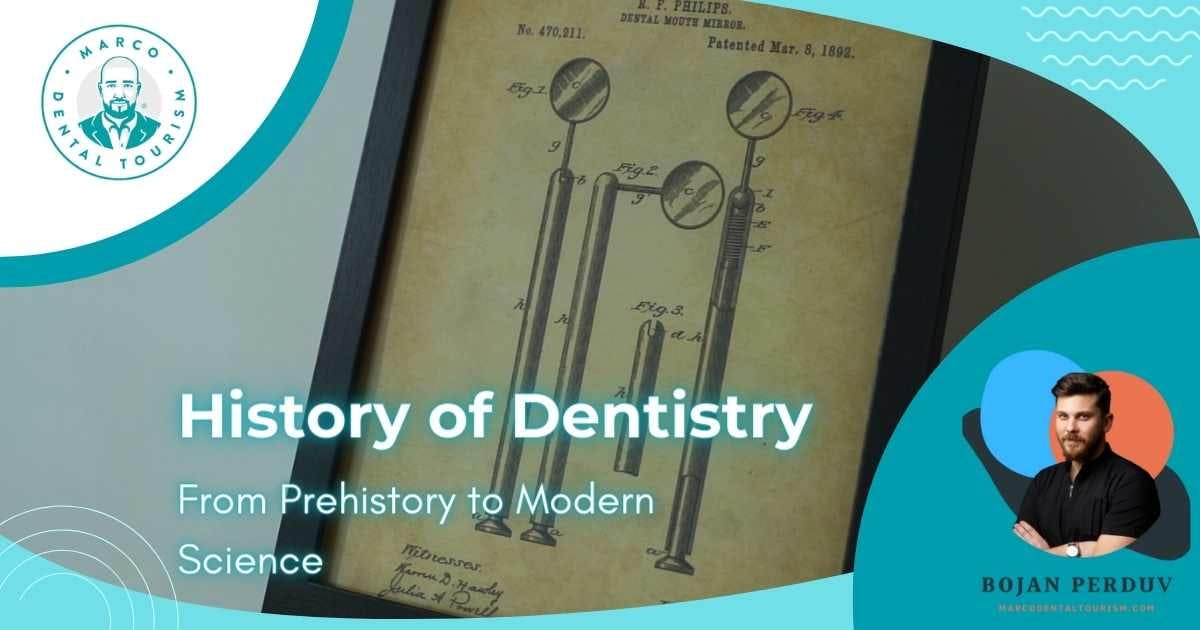
Have you ever wondered how mankind has kept its teeth healthy and strong for thousands of years? From prehistory to modern science, the history of dentistry offers an intriguing and incredibly inspiring insight into the evolution and development of oral and dental care. In this blog, we explore the fascinating journey of dentistry, from the earliest signs of dental care to modern sophisticated treatments that are quickly and easily available to everyone today. If you are ready to find out how far technological and scientific progress has come on the way to a perfect Hollywood smile - let's get started!
What is prehistoric dentistry and what did it look like?
Prehistoric dentistry was a form of oral care used before the invention of modern tools. This included grinding teeth with stone tools and filling cavities with materials such as beeswax. Although the tools were advanced for the era, the process was more primitive and caused more pain.
When did the first dental practice appear in prehistoric times?
Prehistoric dentistry dates back to 7000 BC. Archaeological evidence suggests that people used wooden tools to clean and shape their teeth. They believed in the use of herbs and resins to relieve pain and treat dental problems, which shows that dental care has been important for millennia!
Where and when was the first toothbrush created?

The first toothbrush was created in China back in 1498. Made of boar bristles attached to a bamboo or bone handle, it was used to clean teeth, scrape away plaque and freshen breath. It was a revolutionary discovery of dental hygiene, and became an essential part of everyday life.
What did medieval dentistry look like?

Medieval dentistry is a form of dental care that was practiced between the 5th and 15th centuries. It is characterized by the use of rough tools and techniques, but also by the use of various herbs and spices to reduce pain and infection. In addition, preventive measures such as brushing the teeth with wine or wine vinegar were practiced.
How did dentists work in the Middle Ages?

Medieval dentists were barber-surgeons who provided basic dental care and used rough tools to shape teeth. However, treatments such as fillings and braces were not available. Pain relief was minimal and limited to the use of herbs or honey.
When did modern dentistry as we know it today appear?

Modern dentistry as we know it today began at the beginning of the 19th century with the introduction of dental drills, anesthetics and porcelain fillings. This combination of advances in technology and the development of preventive care has enabled dentists to treat various diseases, as well as replace damaged and missing teeth.
In addition, modern dentistry is characterized by:
Painless treatments: Thanks to the development and use of anesthetics and sedatives, dental treatments are more and more efficient and comfortable for both patients and dentists.
Prevention and early diagnosis: X-rays and other diagnostic tools today make it possible to identify problems before they become serious.
Improved materials: Improved materials such as composites and ceramics successfully and permanently enable the longevity of dental restorations.
Advanced technology: Laser dentistry, implants and root canal treatments are just some examples of incredibly advanced treatments that can be found in modern dentistry every day, and which are the result of rapid dental and technical development of modern times.
Cosmetic Dentistry: Teeth whitening, veneers and other cosmetic treatments such as the Hollywood smile are already commonly used to improve the appearance of teeth, which until recently was almost impossible to imagine.
What are the most important dental innovations of the past few centuries?

The two most important innovations in dentistry are the introduction of anesthesia and the development of dental implants. Anesthesia made it possible to perform complex procedures painlessly, while implants revolutionized the way of replacing missing teeth, which transformed dental practice safer and more efficiently than ever before.
Therefore, we single out the four greatest achievements of modern dental practice that permanently changed and improved the quality of the entire dental service:
Invisalign: A revolutionary orthodontic procedure that uses clear, plastic aligners to gradually straighten teeth without the use of traditional metal braces.
Dental implants: Implants involve a surgical procedure that replaces missing teeth with artificial titanium screws that connect to the jawbone for a safer and more natural-looking dental replacement.
Laser dentistry: Lasers are a minimally invasive procedure that uses laser energy to treat many dental conditions, including tooth decay, gum disease, and teeth whitening.
Digital X-rays: A type of imaging technology used in dentistry that provides detailed images of the teeth and mouth with less radiation exposure than previously used X-rays.
What contributed to the development of dental hygiene?

The development of dental hygiene was most influenced by technological progress in dental care, including the introduction of fluoride, X-rays and modern cleaning tools. In addition, education played an important role because understanding the connection between oral and general health led to leading a healthy lifestyle.
What are the latest materials in use in dentistry?

The newest materials in dentistry are composites, polymers and ceramics. Depending on the need, all these materials give a strong natural-looking result:
Composites: Composite materials are a mixture of resin and glass particles that can be used to fill cavities or repair chipped teeth.
Polymers: Polymers are plastic substances that are usually used to fill caries or to make crowns and bridges.
Ceramics: Ceramics is a non-metallic, strong and durable material, which is why it is commonly used in the production of crowns and veneers, i.e. dental veneers - thin transparent shells that cover the front of the teeth to correct minor irregularities, creating a perfectly attractive smile.
Conclusion on the development of dentistry as a science

Although there is still much to learn and explore, this has been the essence of dentistry - from prehistoric times to today's modern science. We have come a long way from using simple tools to keep our teeth healthy and clean to studying and understanding the complex relationship between oral health and overall well-being. Dentistry is a field that is constantly improving, requiring great dedication, professionalism and passion. As dentists, we are proud to have the privilege of providing our patients with the highest quality of care and positively impacting the quality and health of their lives.














Share your opinion!
What do you think about this topic?
Comments (0)